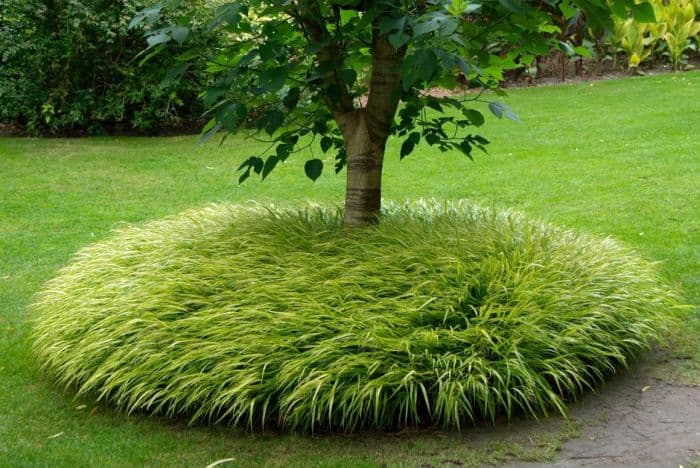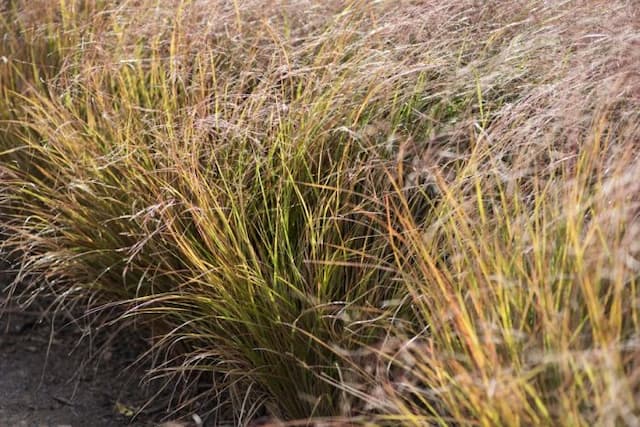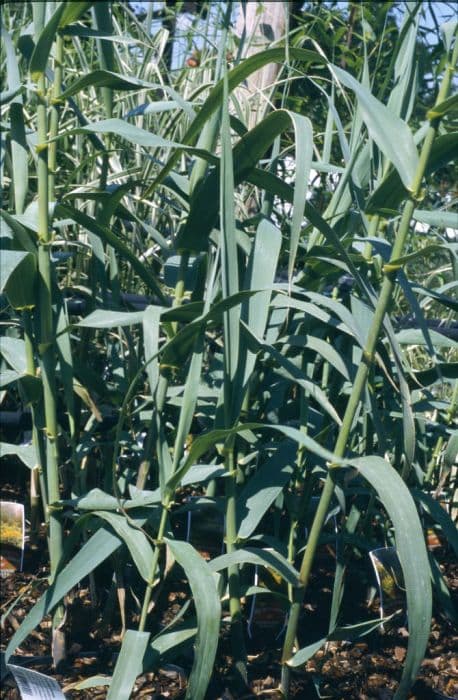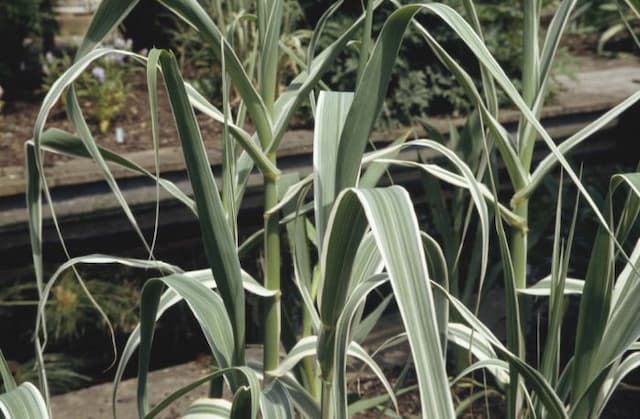Japanese Forest Grass Hakonechloa macra 'Aureola'

ABOUT
The plant commonly known as Japanese forest grass 'Aureola' has a striking and graceful appearance. It exhibits a lush mound of arching stems that give it a cascading, fountain-like look. The leaves of the Japanese forest grass 'Aureola' are particularly eye-catching, with their variegated coloration. Each blade boasts shades of bright yellow and light green, with narrow stripes that can vary in hue, often displaying light yellow, lime, or chartreuse colors. The foliage has a bamboo-like quality and gently rustles in the wind, adding a sense of dynamic movement to the landscape. During different seasons, the Japanese forest grass 'Aureola' undergoes a transformation in color. In the spring and summer, the foliage is more vivid and bright, while in the fall, the leaves can take on tones of pink or reddish hues, adding warmth to the cooler days. Despite the color changes throughout the season, the overall impression remains soft and elegant. The variegation of 'Aureola' provides a striking contrast with surrounding plants and a delightful visual texture that can liven up shaded garden areas. As seasons change, small, inconspicuous flower spikes may emerge, adding an additional layer of interest, but it's the foliage that is the true star. The graceful and flowing nature of the plant makes it a favorite for gardens aiming to achieve a peaceful and serene ambiance, especially in areas with partial to full shade. Its ability to illuminate darker areas of a garden with its bright foliage makes it an invaluable addition to any planting scheme seeking to add a touch of lightness and movement.
About this plant
 Names
NamesFamily
Poaceae.
Synonyms
Japanese Forest Grass, Golden Variegated Hakone Grass, Golden Japanese Forest Grass, Aureola Golden Hakone Grass.
Common names
Hakonechloa macra 'Aureola'.
 Toxicity
ToxicityTo humans
Japanese Forest Grass is not known to be toxic to humans. It's considered a safe ornamental grass and there are no common reports of poisoning from ingesting any part of this plant.
To pets
Japanese Forest Grass is not known to be toxic to pets. It is generally considered safe for dogs, cats, and other animals, and there should be no symptoms of poisoning from ingestion of this plant. However, as with any non-food plant, ingestion of large amounts can potentially cause gastrointestinal upset or blockages simply due to the indigestible nature of plant material.
 Characteristics
CharacteristicsLife cycle
Perennials
Foliage type
Deciduous
Color of leaves
Variegated
Height
1-2 feet (30-60 cm)
Spread
2 feet (60 cm)
Plant type
Grass
Hardiness zones
5
Native area
Japan
Benefits
 General Benefits
General Benefits- Ornamental Appeal: The Japanese Forest Grass 'Aureola' has striking variegated foliage that adds visual interest to gardens.
- Shade Tolerance: It thrives in shady areas where other plants may struggle to grow, offering solutions for difficult garden spots.
- Low Maintenance: This plant has minimal care requirements, making it an easy addition for both novice and experienced gardeners.
- Seasonal Interest: Provides year-round interest with its foliage and seasonal color shifts, enhancing the garden's aesthetic throughout the year.
- Erosion Control: Japanese Forest Grass can help prevent soil erosion in sloped garden areas with its dense growth habit.
- Companion Planting: It pairs well with other shade-loving plants, allowing for beautiful and harmonious garden designs.
- Drought Resistance: Once established, it can tolerate periods of drought, making it suitable for drier climates or water-wise gardens.
- Non-Invasive: Unlike some ornamental grasses, it grows in polite clumps and does not spread aggressively, reducing maintenance and preventing it from overtaking other plants.
- Wildlife Habitat: Though not a major attractant, it can provide shelter for small wildlife in the garden.
- Texture Contrast: The soft, cascading habit of the foliage adds a unique texture that contrasts well with broad-leaf plants or more rigid structures nearby.
 Medical Properties
Medical PropertiesThis plant is not used for medical purposes.
 Air-purifying Qualities
Air-purifying QualitiesThis plant is not specifically known for air purifying qualities.
 Other Uses
Other Uses- Photography Prop: Hakone grass 'Aureola' is often used by photographers to add texture and a splash of color to garden photoshoots.
- Pet Habitat Enrichment: While not a common practice, some pet owners use non-toxic ornamental grasses like Hakone grass to provide natural shelter and stimulation for small pet habitats.
- Erosion Control: The dense, spreading habit of Hakone grass can help stabilize soil on slopes and in garden areas prone to erosion.
- Living Mulch: The thick foliage of Hakone grass can suppress weeds and maintain soil moisture when used as a living mulch around other plants.
- Craft Material: The graceful leaves of Hakone grass can be incorporated into floral arrangements or used in crafting wreaths and other decorations.
- Sound Insulation: In densely planted areas, Hakone grass can contribute to dampening ambient noise in the garden, creating a quieter environment.
- Seasonal Interest: Gardeners may use Hakone grass 'Aureola' to provide four-season interest, as its foliage changes color throughout the year.
- Container Gardening: Hakone grass is suitable for growing in containers, where it can be used as a spiller element in potted arrangements.
- Film and Theater: Hakone grass can be used on set to create a lush, textured backdrop or to simulate natural environments in theatrical productions.
- Education: Horticulture programs and classes could use Hakone grass to teach students about ornamental grass care and landscape design principles.
Interesting Facts
 Feng Shui
Feng ShuiThe Japanese forest grass is not used in Feng Shui practice.
 Zodiac Sign Compitability
Zodiac Sign CompitabilityThe Japanese forest grass is not used in astrology practice.
 Plant Symbolism
Plant Symbolism- Balance: The variegated leaves of the Hakone Grass represent a balance of colors, suggesting harmony and equilibrium in one’s life.
- Elegance: The graceful, cascading form of the Hakone Grass signifies sophistication and refined beauty.
- Resilience: As a durable perennial, this grass symbolizes one's ability to withstand diverse conditions and bounce back from adversity.
- Growth and prosperity: The vigorous growth habit of Hakone Grass can be interpreted as a sign of continuous growth and the potential for prosperity in life.
- Peace: The soft rustling sound of the leaves in the breeze is often associated with tranquility and peace.
 Water
WaterThe Japanese Forest Grass, or Hakone Grass, prefers consistently moist soil, so it's important to water regularly to maintain this moisture level. During the growing season of spring and summer, watering approximately once a week with about 1 to 1.5 gallons per plant will usually suffice, depending on the climate and weather conditions. However, it is crucial not to overwater, as this plant does not tolerate soggy soil, which can lead to root rot. Always check the top inch of soil for dryness before watering again. In the fall and winter, reduce watering as the plant growth slows down, but do not let the soil completely dry out.
 Light
LightJapanese Forest Grass thrives in partial shade, though it can also tolerate full shade. The ideal spot for this plant is one that receives morning sun and afternoon shade, or filtered light throughout the day, as this will highlight its golden variegated foliage without causing leaf scorch. Direct afternoon sun can be too intense and may damage the leaves, so it's best to avoid placing this plant in full sun locations.
 Temperature
TemperatureJapanese Forest Grass prefers temperate climates and is hardy in USDA zones 5 to 9. The ideal temperature range for this plant is between 60 and 75 degrees Fahrenheit. It can survive minimum temperatures down to about -20 degrees Fahrenheit and will go dormant in the winter; however, prolonged exposure to temperatures below 20 degrees Fahrenheit without adequate snow cover could damage the plant.
 Pruning
PruningJapanese Forest Grass benefits from annual pruning to maintain its shape and encourage fresh growth. Prune in late winter or early spring before new shoots emerge by cutting back the foliage to about 4 inches from the ground. This helps remove any dead or damaged leaves from the previous year and stimulates the growth of new, vibrant foliage. Pruning should be done once a year; over-pruning can hinder the plant's natural flowing form.
 Cleaning
CleaningAs needed
 Soil
SoilJapanese Forest Grass prefers a well-draining soil mix with a good amount of organic matter, such as a blend of loam, peat moss, and perlite. The ideal soil pH for 'Aureola' should be slightly acidic to neutral, ranging from 5.5 to 7.0.
 Repotting
RepottingJapanese Forest Grass doesn't like to be disturbed often and should typically be repotted every 2 to 3 years. The clumps can be divided and repotted in the spring when necessary.
 Humidity & Misting
Humidity & MistingJapanese Forest Grass thrives in moderate to high humidity levels but is quite adaptable and can tolerate the humidity found in most home environments.
 Suitable locations
Suitable locationsIndoor
Place in bright, indirect light with moist soil.
Outdoor
Choose a shaded spot; keep soil moist, not wet.
Hardiness zone
5-9 USDA
 Life cycle
Life cycleJapanese Forest Grass (Hakonechloa macra 'Aureola') begins its life cycle as a seed, though it is more commonly propagated by division. After germination, the young grass establishes itself with a network of roots and shoots, entering its vegetative growth phase where it develops the characteristic golden-striped foliage. Once mature, typically in late summer, Japanese Forest Grass will produce inconspicuous greenish flowers that may give way to seed heads, although flowering is often sparse and seeds are not commonly produced in cultivation. Following its blooming, the plant enters a period of dormancy in winter, dying back to the ground to conserve energy. In spring, new growth re-emerges from the surviving root system, repeating the annual growth cycle. Over years, the clumps of Japanese Forest Grass expand outward gradually, sometimes necessitating division to manage its spread and promote vigor.
 Propogation
PropogationPropogation time
Early Spring
Propogation: Hakone grass, known scientifically as Hakonechloa macra 'Aureola', is commonly propagated through division, which is best carried out in the spring as the plant emerges from dormancy. The most popular method is to gently lift the clump from the ground using a garden fork, taking care to keep as much of the root system intact as possible. The clump should then be carefully divided into smaller sections, ensuring that each section has a piece of the root system and several shoots. These divisions can be immediately replanted in the garden or potted up to grow on before transplanting. It is important to water the new divisions well after planting to help establish them. This method of propagation allows gardeners to expand their collection of Hakone grass or share with others while promoting the health and vigor of the parent plant by reducing overcrowding.









